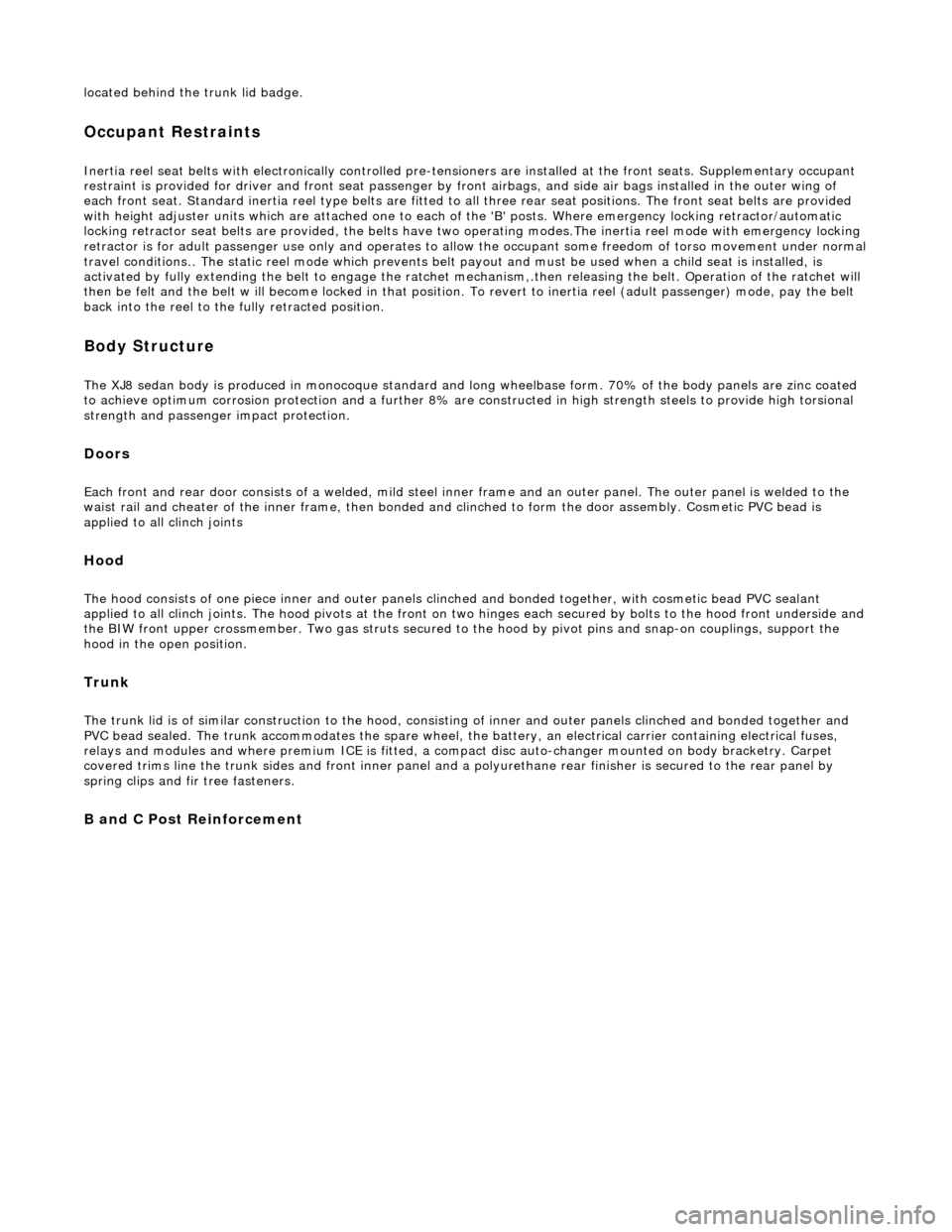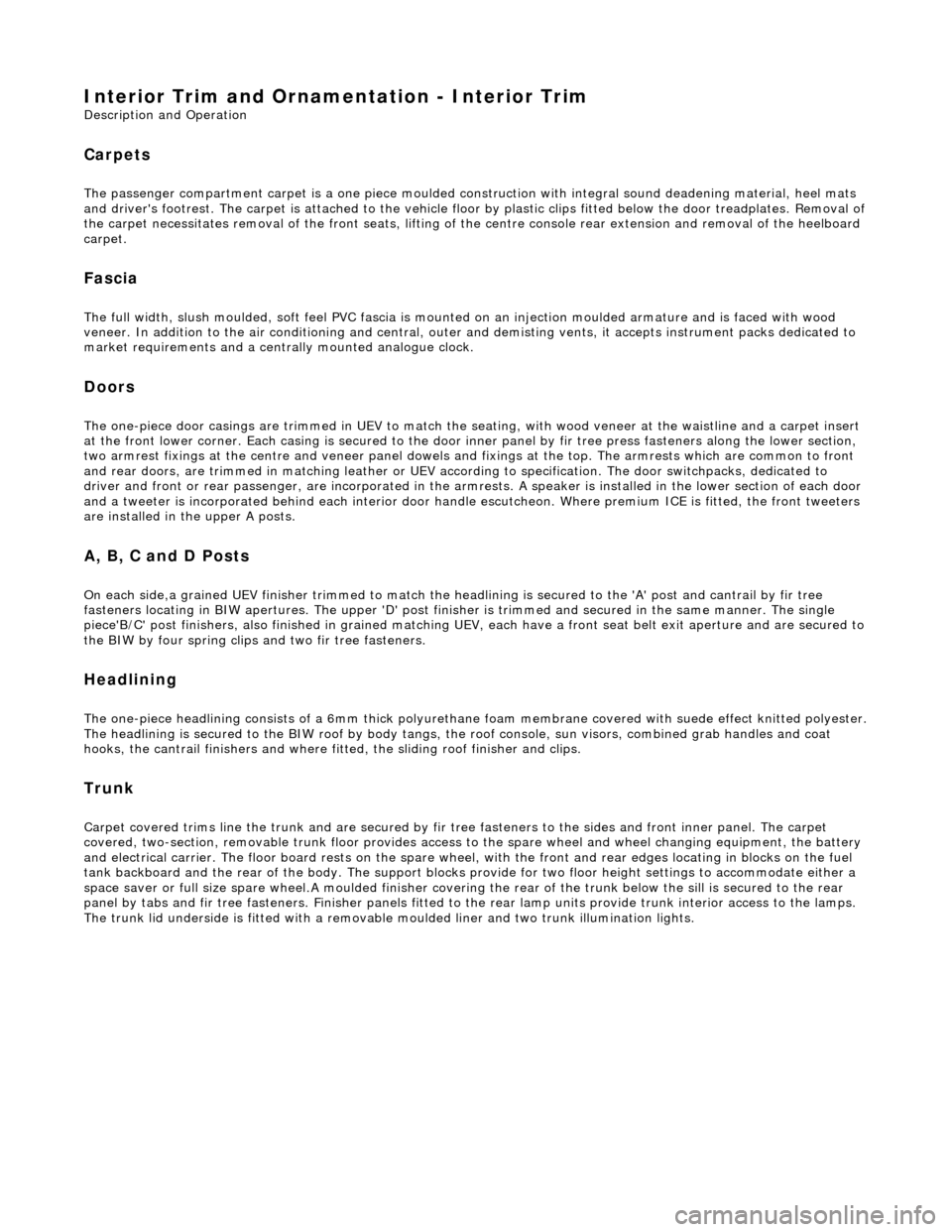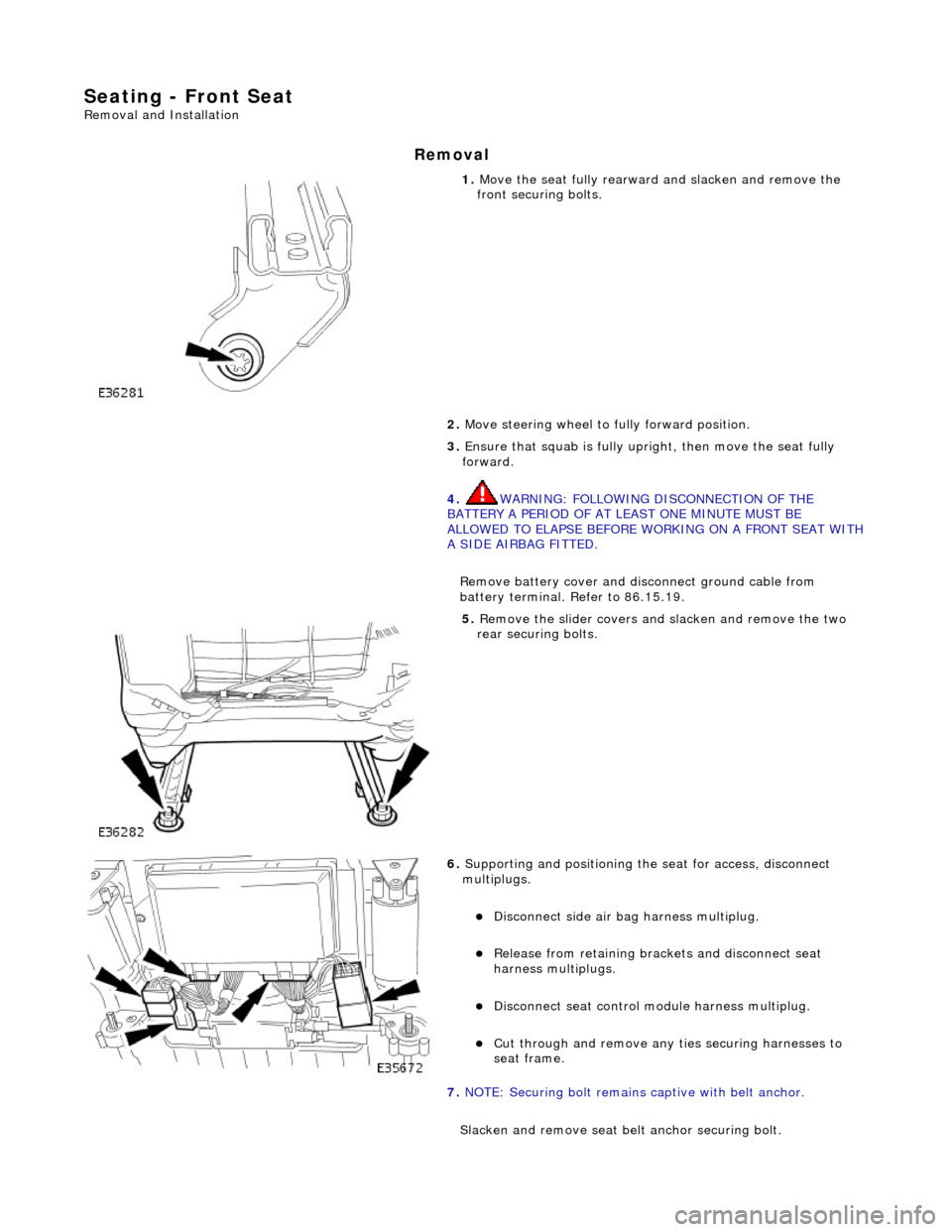Page 2024 of 2490

located behind the trunk lid badge.
Occupant Restraints
Inertia reel seat belts with electronically controlled pre-tensioners are installed at the front seats. Supplementary occupant
restraint is provided for driver and front seat passenger by front airbags, and side air bags installed in the outer wing of
each front seat. Standard inertia reel type belts are fitted to all three rear seat positions. The front seat belts are provide d
with height adjuster units which are attached one to each of the 'B' posts. Where emergency locking retractor/automatic
locking retractor seat belts are provided, the belts have two operating modes.The inertia reel mode with emergency locking
retractor is for adult passenge r use only and operates to allow the occupant some freedom of tors o movement under normal
travel conditions.. The static reel mode which prevents belt payout and must be used when a ch ild seat is installed, is
activated by fully extending the belt to engage the ratchet me chanism,.then releasing the belt. Operation of the ratchet will
then be felt and the belt w ill become locked in that position. To revert to in ertia reel (adult passenger) mode, pay the belt
back into the reel to th e fully retracted position.
Body Structure
The XJ8 sedan body is produced in monocoque standard and lo ng wheelbase form. 70% of the body panels are zinc coated
to achieve optimum corrosion protection and a further 8% are constructed in high st rength steels to provide high torsional
strength and passenger impact protection.
Doors
Each front and rear door consists of a we lded, mild steel inner frame and an outer panel. The outer panel is welded to the
waist rail and cheater of the inner frame, then bonded and clinched to fo rm the door assembly. Cosmetic PVC bead is
applied to all clinch joints
Hood
The hood consists of one piece inner an d outer panels clinched and bonded toge ther, with cosmetic bead PVC sealant
applied to all clinch joints. The hood pivo ts at the front on two hinges each secured by bolts to the hood front underside and
the BIW front upper crossmember. Two gas struts secured to the hood by pi vot pins and snap-on couplings, support the
hood in the open position.
Trunk
The trunk lid is of similar construction to the hood, consisting of inner and outer panels clinched and bonded together and
PVC bead sealed. The trunk accommodates the spare wheel, the battery, an electrical carrier containing electrical fuses,
relays and modules and where premium ICE is fitted, a compac t disc auto-changer mounted on body bracketry. Carpet
covered trims line the trunk sides and front inner panel and a po lyurethane rear finisher is secured to the rear panel by
spring clips and fir tree fasteners.
B and C Post Reinforcement
Page 2054 of 2490

Interior Trim and Ornamentation - Interior Trim
Description and Operation
Carpets
The passenger compartment carpet is a one piece moulded constr uction with integral sound deadening material, heel mats
and driver's footrest. The carpet is attach ed to the vehicle floor by plastic clips fitted below the door treadplates. Removal of the carpet necessitates re moval of the front seats, lifting of the centre console rear extens ion and removal of the heelboard
carpet.
Fascia
The full width, slush moulded, soft feel PVC fascia is mounted on an injection moulded armature and is faced with wood
veneer. In addition to the air conditioning and central, outer and demisting vents, it accepts instrument packs dedicated to
market requirements and a centrally mounted analogue clock.
Doors
The one-piece door casings are trimmed in UEV to match the seating, with wood veneer at the waistline and a carpet insert
at the front lower corner. Each casing is secured to the door inner panel by fir tree press fast eners along the lower section,
two armrest fixings at the centre and vene er panel dowels and fixings at the top. The armrests which are common to front
and rear doors, are trimmed in matching leather or UEV according to specification. The door switchpacks, dedicated to
driver and front or rear passenger, are in corporated in the armrests. A speaker is in stalled in the lower section of each door
and a tweeter is incorporated behind each interior door handle escutcheon. Where premium ICE is fitted, the front tweeters
are installed in the upper A posts.
A, B, C and D Posts
On each side,a grained UEV finisher trimmed to match the headlining is secured to the 'A' post and cantrail by fir tree
fasteners locating in BIW apertures. The upper 'D' post finisher is trimmed and secured in the same manner. The single
piece'B/C' post finishers, also finished in grained matching UEV, each have a front se at belt exit aperture and are secured to
the BIW by four spring clips and two fir tree fasteners.
Headlining
The one-piece headlining consists of a 6mm thick polyurethane foam membrane covered with suede effect knitted polyester. The headlining is secured to the BIW roof by body tangs, the roof console, sun visors, combined grab handles and coat
hooks, the cantrail finishers and where fitt ed, the sliding roof finisher and clips.
Trunk
Carpet covered trims line the trunk and are secured by fir tr ee fasteners to the sides and front inner panel. The carpet
covered, two-section, removable trunk fl oor provides access to the spare wheel and wheel changing equipment, the battery
and electrical carrier. The floor board rests on the spare wheel, with the front and rear edges locating in blocks on the fuel
tank backboard and the rear of the body. The support blocks provide for two floor he ight settings to accommodate either a
space saver or full size spare wheel.A moulded finisher covering the rear of the trunk below the sill is secured to the rear
panel by tabs and fir tree fasteners. Finish er panels fitted to the rear lamp units provide trunk interior access to the lamps.
The trunk lid underside is fitted with a removabl e moulded liner and two trunk illumination lights.
Page 2056 of 2490
Interior Trim and Ornamentation - B-Pillar Trim Panel
Removal and Installation
Removal
1. Position front seat and squab fully forward.
2. Remove front seat belt upper and lower anchorages. Refer to
76.73.10.
3. Remove escutcheon from trim pad aperture and seat belt.
4. Remove draught welts from adjace nt door aperture flanges.
5. Using a trim removal tool and exercising care to avoid
damage, remove and discard th e two fir tree fasteners from
bottom of trim.
6. Carefully ease centre of trim pad inwards to release four
spring clips.
Page 2057 of 2490
Installation
7. Pass seat belt and fittings through trim pad aperture.
8. Remove trim pad from vehicle.
1. Position trim pad at B/C post an d pass seat belt and fittings
through aperture.
2. Firmly press centre of trim pad to fully seat spring clips.
3. Ensuring that adjacent dowels are correctly located in B/C
post, fit and full y seat new fir tree fasten ers to secure bottom
of trim pad
4. Fit draught welts to adjacent door aperture flanges.
5. Fit seat belt upper and lower anchorag es. Refer to 76.73.10.
6. Return seat to original position.
Page 2122 of 2490

Seating - Front Seat
Removal and Installation
Removal
1. Move the seat fully rearward and slacken and remove the
front securing bolts.
2. Move steering wheel to fully forward position.
3. Ensure that squab is fully upright, then move the seat fully
forward.
4. WARNING: FOLLOWING DISCONNECTION OF THE
BATTERY A PERIOD OF AT LEAST ONE MINUTE MUST BE
ALLOWED TO ELAPSE BEFORE WORKING ON A FRONT SEAT WITH
A SIDE AIRBAG FITTED.
Remove battery cover and disc onnect ground cable from
battery terminal. Refer to 86.15.19.
5. Remove the slider covers an d slacken and remove the two
rear securing bolts.
6. Supporting and positioning the seat for access, disconnect
multiplugs.
Disconnect side air bag harness multiplug.
Release from retaining brackets and disconnect seat
harness multiplugs.
Disconnect seat control module harness multiplug.
Cut through and remove any ti es securing harnesses to
seat frame.
7. NOTE: Securing bolt remains captive with belt anchor.
Slacken and remove seat be lt anchor securing bolt.
Page 2123 of 2490
Installation
8. Exercising care to avoid damagi ng side air bag, remove seat
from vehicle.
1. Position seat in vehicle, align seatbelt anchor and fit and
tighten seat belt securing bolt.
2. Supporting seat for access, co nnect seat and side airbag
harness multiplugs and secure harnesses to seat frame using
new ties.
3. Fit, but do not fully tigh ten rear securing bolts.
4. Connect ground cable to battery terminal and fit battery cover.
Refer to 86.15.15.
5. Position seat fully rearward an d fit and tighten front securing
bolts
6. Position seat fully forward, full y tighten rear securing bolts and
fit slider covers.
7. Return seat to original position.
Page 2147 of 2490
Seating - Front Seat Track
Removal and Installation
Removal
1. WARNING: FOLLOWING DISCONNECTION OF THE
BATTERY A PERIOD OF AT LEAST ONE MINUTE MUST BE
ALLOWED TO ELAPSE BEFORE WORKING ON A FRONT SEAT WITH
A SIDE AIRBAG FITTED.
Remove battery cover and disc onnect ground cable from
battery terminal. Refer to 86,.15.19.
2. Remove front seat from vehicle. Refer to 76.70.01.
3. Invert seat for access.
4. Slacken and remove LH slide se curing bolts and remove seat
belt anchor mounting bracket.
5. Slacken and remove RH slide se curing bolts and remove seat
belt buckle moun ting bracket.
6. Disconnect seat cushion tilt motor drive cables.
7. Remove slide assembly.
1. Position slide/motor assembly for access and release seat harness securing clips.
2. Drill out pop rivets securing slide to motor frame.
Page 2148 of 2490
Installation
8. Withdraw LH slide from seat motor potentiometer/gearbox
assembly.
1. Fit and fully seat slide to po tentiometer/gearbox assembly.
2. Position motor frame on slide assembly and secure with new
pop rivets.
3. Connect seat cushion tilt motor drive cables.
4. Secure seat harness in clips.
5. Position slide assembly on seat.
6. Fit and align RH seat belt bu ckle mounting bracket between
slide and seat pivot bracket and fit but do not tighten securing
bolts.
7. Fit and align LH seat belt an chor bracket between slide and
seat pivot bracket an d fit but do not tighten securing bolts.
8. Fit but do not tighten RH and LH slide front securing bolts.
9. Finally tighten slide front and rear securing bolts.
10. Fit front seat to vehi cle. Refer to 76.70.01.